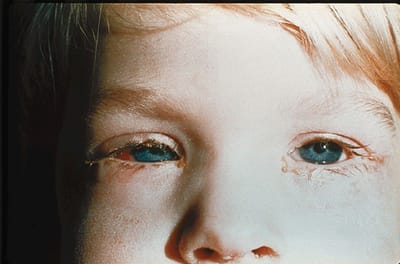Conjunctivitis


CONJUNCTIVITIS
 |
|  Conjunctivitis in older children presents no unusual diagnostic problems. Aetiological factors may be:-
Conjunctivitis in older children presents no unusual diagnostic problems. Aetiological factors may be:-1. Bacterial Conjunctivitis
Clinical Findings :
-Red eyes – usually bilateral, sore (but not painful)
- Muco-purulent discharge
Diagnosis - Gram stain and culture
Therapy - Eye toilets + Local antibiotic drops second hourly
2. Viral Conjunctivitis (adenovirus) Adeno Viral Conjunctivitis
Clinical Findings
- Frequently unilateral initially
- Red eye
- Watery discharge
- Tender preauricular lymph node
- Follicles visible on tarsal conjunctival
Diagnosis
– Clinical features + Culture (e.g. Adeno Virus)
Therapy
- Supportive
- Hot Spoon bathing
3.Allergic Conjunctivitis- Spring catarrh, vernal conjunctivitis
Clinical Findings
- Itchy eye, Rubbing of eyes
- Watery discharge
- No injection
- Cobblestone papillae on tarsal conjunctival PAPILLAE
- Beware of Photophobia or reduced vision –This signifies corneal involvement and possible serious loss of vision! CORNEAL ULCERATION
due to Keratitis
Diagnosis
– Eosinophils in conjunctival scraping
Therapy
- Minor case –trial with vasoconstrictors- Naphcon A, Albalon A
- Mast Cell Stabilisers-Patanol . Effectivity is limited in children. Drops must be used regularly 3 or 4 times daily even when asymptomatic to stabilise Mast Cells. They are of no value used only when symptoms occur because they take some time to have an effect. Compliance with these medications is extremely poor and I find their practical value is minimal.
-Local steroid drops- Continue to be the most effective available topical medication for severe Vernal conjunctivitis. Their use requires monitoring because of their possible effect on Intra Ocular Pressure. I have often seen vision lost as a result of failure to control Allergic Keratoconjunctivitis because of fears regarding steroid use. Steroid raised pressure in children is rare, I have not seen vision lost from this complication in childhood. Monitor the dose of steroids, adjusting the dose according to the response. There is usually a gradual reduction in the number of applications required and eventual cessation in teenage life.
4. Neonatal Conjunctivitis
Conjunctivitis in the neonate may be a sight threatening condition. GONOCOCCAL CONJUNCTIVITIS
Severe Purulent conjunctival infection in this age group can result in corneal involvement and even rupture.
Aetiological Agents:
- Gonococcal – (classical but rare) culture
- Other Bacteria – culture, gram stain
- Chlamydia – smear; REMEMBER PNEUMONITIS
- Herpes simplex – culture
Therapy :
- Admit to hospital
- Hourly eye toilets
-Hourly antibiotic drops
-Appropriate systemic antibiotics
Prompt adequate therapy in patients with neonatal conjunctivitis should prevent corneal complication and permanent visual impairment.
return to previous page


